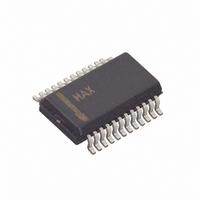MAX8650EEG+ Maxim Integrated Products, MAX8650EEG+ Datasheet - Page 17

MAX8650EEG+
Manufacturer Part Number
MAX8650EEG+
Description
IC CNTRLR STP DWN 24-QSOP
Manufacturer
Maxim Integrated Products
Type
Step-Down (Buck)r
Datasheet
1.MAX8650EEG.pdf
(25 pages)
Specifications of MAX8650EEG+
Internal Switch(s)
No
Synchronous Rectifier
No
Number Of Outputs
1
Voltage - Output
0.7 ~ 5.5 V
Current - Output
25A
Frequency - Switching
200kHz ~ 1.2MHz
Voltage - Input
4.5 ~ 28 V
Operating Temperature
-40°C ~ 85°C
Mounting Type
Surface Mount
Package / Case
24-QSOP
Power - Output
762mW
Output Voltage
0.7 V to 5.5 V
Output Current
25 A
Input Voltage
4.5 V to 28 V
Mounting Style
SMD/SMT
Maximum Operating Temperature
+ 85 C
Minimum Operating Temperature
- 40 C
Lead Free Status / RoHS Status
Lead free / RoHS Compliant
To set the output voltage for the MAX8650, connect FB
to the center of an external resistor-divider from the out-
put to GND (R9 and R10 of Figure 3). Select R9
between 8kΩ and 24kΩ, and then calculate R10 with
the following equation:
where V
close to the IC as possible.
To set the overvoltage threshold voltage for the
MAX8650, connect OVP to the center of an external
resistor-divider from the output to GND (R11 and R12 of
Figure 3). Select R11 between 8kΩ and 24kΩ, then cal-
culate R12 with the following equation:
where V
When using an external reference, V
V
For most applications where the duty cycle is less than
50%, connect SCOMP to GND to set the slope com-
pensation to the default of 125mV/T, where T is the
oscillator period (T = 1 / f
Figure 5. Inductor-Current Waveform
REFIN
.
OVP
FB
= 0.7V. R9 and R10 should be placed as
4.5V to 28V Input Current-Mode Step-Down
= 0.8V when using the internal reference.
Setting the Slope Compensation
Setting the Output Overvoltage
R
R
10
12
______________________________________________________________________________________
=
=
Setting the Output Voltage
R
R
11
9
TIME
S
×
Controller with Adjustable Frequency
×
).
⎛
⎜
⎝
Design Procedure
⎛
⎜
⎝
V
Protection Threshold
V
V
V
OUT
FB
OUT
OVP
−
−
1
1
⎞
⎟
⎠
⎞
⎟
⎠
OVP
I
I
I
is 115% of
PEAK
LOAD
VALLEY
For a slope compensation of 250mV/T, connect
SCOMP to AVL.
For applications with a duty cycle greater than 50%, set
the SCOMP voltage with a resistor voltage-divider from
AVL to GND (R3 and R4 in Figure 6). First, use the fol-
lowing equation to find the SCOMP voltage:
where R
the switching frequency.
Next, select a value for R3, typically 10kΩ, and solve
for R4 as follows:
This sets the slope-compensation voltage rate to
V
There are several parameters that must be examined
when determining which inductor is to be used. Input
voltage, output voltage, load current, switching fre-
quency, and LIR. LIR is the ratio of inductor-current rip-
ple to maximum DC load current. A higher LIR value
allows for a smaller inductor, but results in higher loss-
es and higher output ripple. A good compromise
between size and efficiency is an LIR of 0.3. Once all
the parameters are chosen, the inductor value is deter-
mined as follows:
Figure 6. Resistor-Divider for Setting the Slope Compensation
SCOMP
L
/ (10 x T).
is the DC resistance of the inductor, and f
L
=
V
V
SCOMP
R
IN
MAX8650
4
V
=
×
OUT
(
f
S
5
V V
=
SCOMP
×
−
×
I
V
LOAD MAX
AVL
OUT
(
V
V
SCOMP
SCOMP
IN
f
S
(
−
×
Inductor Selection
×
V
60
OUT
L
R4
R3
)
)
×
×
×
R
R
)
LIR
L
3
S
17
is











